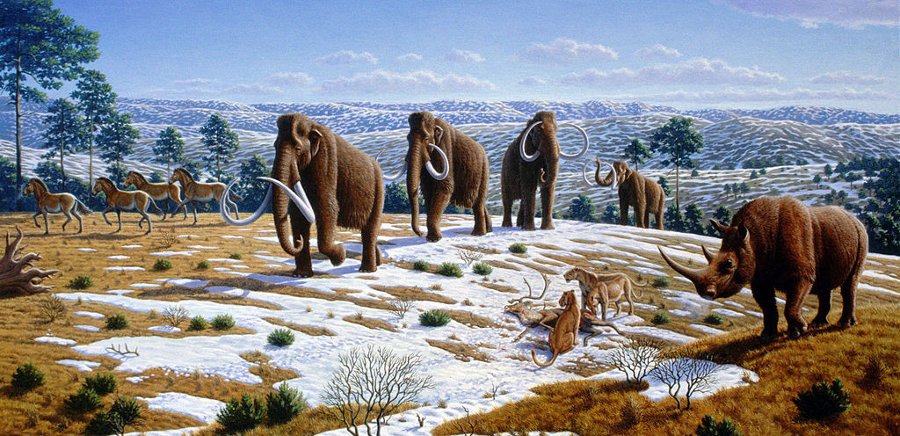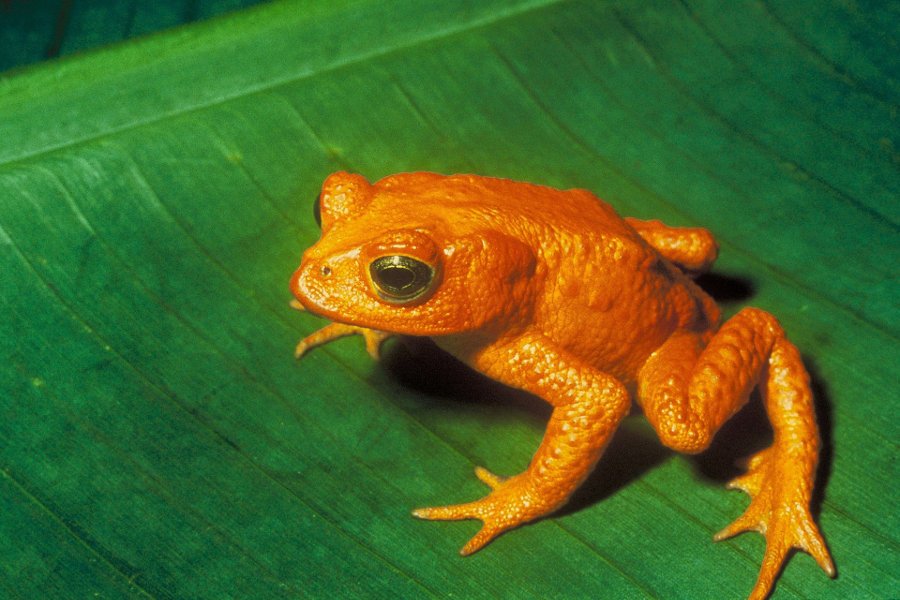Did you know that 98% of all species that have ever lived on earth are extinct? Almost every species of bacterium, plant, fish or animal that's ever lived is gone.

Late Pleistocene landscape of northern Spain, by Mauricio Antón
source: Wikipedia
Our planet is more than 4 billion years old, and has sustained life for approximately 3 billion of those years. In this vast amount of time species have been coming in and out of existence through natural selection at a fairly steady rate, but there have been some notable short periods of time (on a geological scale) in which huge numbers of species suddenly died out. I wrote about the planet's very first mass extinction event called The Oxygen Catastrophe when the earths atmosphere became "breathable" for life as we know it now, and almost all single celled organisms died because oxygen was a toxic gas to them.
Somehow this first mass extinction event isn't part of the official five extinction events usually identified by scientists; the first "official" major extinction event was around 450 million years ago when between 60 and 70% of all species died. Here's all of them, with the last one being the most well known as the asteroid that killed the dinosaurs:
1. Ordovician–Silurian extinction events (End Ordovician or O–S): 450–440 Ma (million years ago) at the Ordovician–Silurian transition. Two events occurred that killed off 27% of all families, 57% of all genera and 60% to 70% of all species. Together they are ranked by many scientists as the second largest of the five major extinctions in Earth's history in terms of percentage of genera that became extinct.
2. Late Devonian extinction: 375–360 Ma near the Devonian–Carboniferous transition. At the end of the Frasnian Age in the later part(s) of the Devonian Period, a prolonged series of extinctions eliminated about 19% of all families, 50% of all genera and at least 70% of all species. This extinction event lasted perhaps as long as 20 million years, and there is evidence for a series of extinction pulses within this period.
3. Permian–Triassic extinction event (End Permian): 252 Ma at the Permian–Triassic transition. Earth's largest extinction killed 57% of all families, 83% of all genera and 90% to 96% of all species (53% of marine families, 84% of marine genera, about 96% of all marine species and an estimated 70% of land species, including insects). The highly successful marine arthropod, the trilobite, became extinct. The evidence regarding plants is less clear, but new taxa became dominant after the extinction. The "Great Dying" had enormous evolutionary significance: on land, it ended the primacy of mammal-like reptiles. The recovery of vertebrates took 30 million years, but the vacant niches created the opportunity for archosaurs to become ascendant. In the seas, the percentage of animals that were sessile dropped from 67% to 50%. The whole late Permian was a difficult time for at least marine life, even before the "Great Dying".
4. Triassic–Jurassic extinction event (End Triassic): 201.3 Ma at the Triassic–Jurassic transition. About 23% of all families, 48% of all genera (20% of marine families and 55% of marine genera) and 70% to 75% of all species became extinct. Most non-dinosaurian archosaurs, most therapsids, and most of the large amphibians were eliminated, leaving dinosaurs with little terrestrial competition. Non-dinosaurian archosaurs continued to dominate aquatic environments, while non-archosaurian diapsids continued to dominate marine environments. The Temnospondyl lineage of large amphibians also survived until the Cretaceous in Australia (e.g., Koolasuchus).
5. Cretaceous–Paleogene extinction event (End Cretaceous, K–Pg extinction, or formerly K–T extinction): 66 Ma at the Cretaceous (Maastrichtian) – Paleogene (Danian) transition interval. The event formerly called the Cretaceous-Tertiary or K–T extinction or K–T boundary is now officially named the Cretaceous–Paleogene (or K–Pg) extinction event. About 17% of all families, 50% of all genera and 75% of all species became extinct. In the seas all the ammonites, plesiosaurs and mosasaurs disappeared and the percentage of sessile animals (those unable to move about) was reduced to about 33%. All non-avian dinosaurs became extinct during that time. The boundary event was severe with a significant amount of variability in the rate of extinction between and among different clades. Mammals and birds, the latter descended from theropod dinosaurs, emerged as dominant large land animals.
source: Wikipedia

The Golden Toad of Costa Rica, extinct since around 1989
source: Wikipedia
The Jurassic Park movies play on our sense of wonder and awe about the great animals that ruled the planet until approximately 60 milion years ago; we now know why they suddenly became extinct as it's largely agreed that the cause was the impact of a large comet that left The Chicxulub crater buried underneath the Yucatán Peninsula in Mexico. Back then 75% of all animal and plant species became extinct.
The reason why I tell all this, and why I hope you're rather impressed by the numbers and percentages, is that we are currently living in the sixth major extinction event, and this time we are the comet! Below is a video with a good explanation by a paleontologist, and I was shocked to learn that if the current extinction rate lasts for another 10 centuries, which is a geological blink of an eye, we would match the previous events and kill three quarters of all known species. And the estimations on the current extinction rate are bound to be on the low side, since not nearly all species are identified yet; a lot will die without us even noticing.
Are we in a "Sixth Extinction"?
A "biological annihilation" of wildlife in recent decades means a sixth mass extinction in Earth’s history is under way and is more severe than previously feared, according to research.
source: The Guardian - Monday July 10th 2017
Never heard about the California Golden Bear, the Great Auk, the Passenger Pigeon, the Pinta Island Tortoise or the Golden Toad of Costa Rica? Don't worry: they're all extinct and you'll never see a live one again. They've all died out in recent years because of our impact on the planet's environments and atmosphere. We've even already got a name for our very own, self-made mass extinction: the Holocene Extinction.
What I wonder is this: what is it about us humans that makes us blind to these developments and just keep on doing what we're doing? We most certainly know what we're causing, how we're causing it and what can be done about it, yet we do nothing and keep obeying the rules of the economical game we made religion. We keep wasting huge amounts of energy and burning huge amounts of carbon-based fuels by overproducing everything and throwing away the excess shit we don't really need.
Many will have you believe it's because there's too much of us, that the planet simply cannot sustain 7 billion people without raping the earth of every resource twice as fast as it can grow them back. Don't fall for that obvious lie, please. We produce food for 12 billion people but manage to not feed the 7 billion that are actually there... It's capitalism and it's irrational demand for perpetual growth that is the real modern day comet that's killing life in record speeds.
When I think about this I sometimes want to cry. We're such smart and essentially well meaning beings, so how can we keep acting like fools in the face of certain self destruction? Remember the panic about the bees dying world wide? Has that been resolved yet? Are bees still disappearing everywhere? If they die... I dare not speculate what'll happen...
Provided we're all still here tomorrow, I promise I'll be back here, hopefully with some more positive thoughts to share.... Keep alive and steeming brothers and sisters!

Recent articles you might be interested in:

Thanks for stopping by and reading. If you really liked this content, if you disagree (or if you do agree), please leave a comment. Of course, upvotes, follows, resteems are all greatly appreciated, but nothing brings me and you more growth than sharing our ideas. It's what Steemit is made for!


Just for Full Disclosure, I'm invested in these crypto-currencies:
Bitcoin | Litecoin | EOS | OmiseGo | FunFair | KIN | Pillar | DENT | Polymath | XDCE | 0x | Decred | Ethereum | Carmel | XYO
